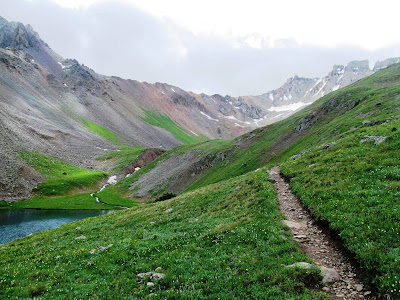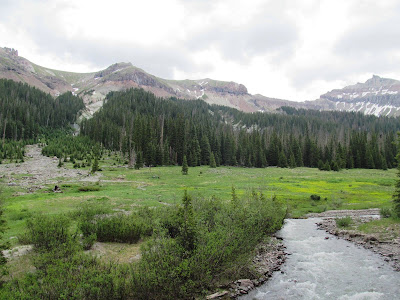“We simply need that wild country available to us, even if
we never do more than drive to its edge and look in”
—Wallace
Stegner,
the “Wilderness Letter” for the Outdoor Recreation Resources Review
Commission / The Sound of Mountain Water
 |
| View of Painted Wall from the North Rim |
On the
second day of orientation for new seasonal employees, having already learned
about safety, personnel, management, and the overall NPS mission, we were briefed
on park-specific resources and founding purposes: water, ecosystems, history.
Wilderness.
“This is
the closest many people will ever come to wilderness,” the ranger said of the
scenic overlooks at Black
Canyon,
I involuntarily
gasped and must have grimaced.
She
turned to me and, acknowledging my look of incredulity, proceeded to explain:
those who are physically incapable of trekking through rugged terrain,
unequipped to navigate great distances, and/or prefer not to experience the
tiredness, soreness, and inherent danger that accompany long hikes into distant
places have at Black Canyon a unique opportunity to drive right to the edge
of the deep, narrow chasm and gaze down into the heart of a capital-W
Wilderness. They can see it up close.
They can feel the heat rising from the rocks, the coolness emanating
from shadows. They can smell the sage after rain, juniper baking in hot
sun. They can hear birdcalls echoing,
wind rustling, and, of course, the river—the river roaring, rushing, tumbling
on down between the rock walls, several thousand feet away but ever so close, ever
so wild.
 |
| View of the canyon from the North Rim, colors sharp after a rainstorm |
True. And
yet…
Not
knowing whether the ranger’s original statement had used a generic term or
proper noun—“the closest they’ll ever come to [a federally-designated]
Wilderness [Area]”?—I continued to wince, writhe, wring my hands as she continued to describe the park's attributes. Even if her points were technically
right—yes, most park landscapes still have some trace of man (trails, if not
roads and buildings); yes, many Wilderness Areas are seen from too far away to
be understood and appreciated; and yes, individuals all have different
perceptions of wildness—something in me protested that standing at a pull-out
ogling a place doesn’t count as truly experiencing it. “What of the humility, the fear?” I wanted to
ask, “What of awe? Do visitors feel vulnerable, exposed? Small, self-reliant,
fully alive out alone in a big, wild
place?”
I barely managed to keep my
mouth shut—it wasn't the appropriate time or place for a debate. Instead of arguing (Ed Abbey [The
Monkey Wrench Gang]: “Challenge that statement. I challenge that statement. With what? I
don’t know”), I scribbled fiercely in a notebook.
Now,
three months later, I’m looking at my notes and still wondering if and how to challenge that
statement. Assuming that experience nurtures
appreciation and informs preservation, can muted experience still inspire strong appreciation? Does flattened or dulled appreciation lead to weakened
preservation? Does the “wilderness idea”
need more preachers or more defenders?
What experiences are visitors to Black Canyon
 |
| How to tell whether you're in a park service wilderness or on BLM rangeland |
****
For that
matter, what did I see, do, and learn this summer?
U.S. Forest Service Wilderness Areas (Sneffels,
Weminuche, Wetternhorn): Snow, rock, flowers; dogs, tents, people. Steep,
challenging, breathtakingly beautiful—cool blue pools nestled in the alpine
tundra, reflecting rocky ridges—but trails are not wilderness. I saw more
wooden signs than signs of wildlife, met more people than wild deors, never
quite felt free to wander. Plus, I felt guilty for having to drive so far to
hike.
 |
| Pool near Upper Ice Lake (technically not a Wilderness, but pretty.) |
The park
road: stars, solitude, surely mountain lions watching from the brush. Striding
along through the early morning darkness with the Milky Way arcing overhead,
solid pavement underfoot, and susurrations of the river rising up from the
impossibly deep canyon, I came close to feeling untrammeled, but also felt safe
and secure enough to be walking alone before dawn, wearing sandals and carrying
no emergency supplies (aside from a thermos of coffee).
 |
| Sunrise, softly bringing the world into focus |
Rock
Point: sanity, serenity, wingbeats of wrens. I didn’t sit out there
enough.
 |
| Rock Point. Yes, wildness, if not wilderness. |
****
My final
weekend in Colorado , I decided to return to the
Uncompahgre Wilderness—the same route I’d attempted in early July, up the West
Fork of the Cimarron aiming for Wetterhorn
Basin
This
time, I knew to get an earlier start, carry a lighter pack, and follow the
trail. My goal wasn’t to have a “wilderness experience,” but rather to make it
over the pass into the basin, enjoying the fresh air and the picturesque views
along the way. I hiked at a fast but not
grueling pace, pausing to marvel at the wildflower-filled meadows and stopping repeatedly to put on and take off rain gear. It took about an hour to get to
the waterfalls (the spot that had taken nearly 4 hours to reach in July),
then another hour-ish to weave up the mostly-snowfree center of the cirque.
 |
| View down the West Fork valley, with less snow |
 |
| Flowers! |
 |
| So many flowers! |
I
kept telling myself to slow down and appreciate the day—bright
sunshine breaking through as clouds began to clear; patches of blue sky
appearing over rusty ridges; fat, golden marmots whistling from the rocks—but
the pass drew me onward, upward. After a final push, I came over a crest of rock and moss and
felt the landscape open out underneath me: a swoop of tundra and rock slid into a forested drainage; barren ridges rose back up on the far side. Beyond
the basin: mountains, and mountains, and mountains. I didn’t recognize any of their profiles or
know any of their names, but I was awfully happy to see them.
 |
| Pass into Wetterhorn Basin |
Intending
to sit and soak in the scenery for a while, I left the trail and began
rock-hopping in search for the perfect spot. I was concentrating so much on
where to put my feet that I lost awareness of the larger landscape. It wasn’t
until I’d dropped my pack and turned to sit that I realized, with a gasp, that
I could see Wetterhorn Peak itself dominating the far horizon.
Some
landmarks—Pilot Rock (Petrified Forest National Park), Fang Mountain (Denali
National Park), Algonquin Peak, as seen rising up over Wright (the
Adirondacks)—have a certain ineffable prominence or presence that draws
attention and commands respect. Their size or height or aloneness makes them physical manifestations of awe. Seeing
them, it’s easy to understand why cultures worldwide have believed mountains to
be the homes of gods.
Wetterhorn
is one of those peaks.
 |
| Wetterhorn Peak -- the jagged tooth to the left |
****
On the
way back down (I didn’t stay long—feared the feeling of sacrosanctity would
fade), I crossed paths with the first people I’d seen all day: two older women,
friends who said they try to hike the trail (their favorite) together every
year. They were positively glowing,
delighted to be out there and just as surprised and delighted to meet me—a lone
girl from New York (New York!) who was also delighted to be out there, learning
the trail’s twists and turns, celebrating its secrets, its marvels. We chatted
briefly, then parted with wishes for lifetimes of “happy hiking!”
 |
| Grove of elephant flower (Pedicularis groenlandica) |
Continuing
down, I saw only one other group—a family of four, strung out. The son, who was far in the lead, greeted me
with a gasp of, “Did you do Wetterhorn?”
Rather
than getting annoyed with the idea of peak-bagging or defensive of the fact
that I’d “only” gone to the pass, I surprised myself by automatically and
honestly replying: “Oh, no, thank you! I only wanted to see it.”
It was enough to
hike to the edge of the wilderness and look in, to know it's there.













































